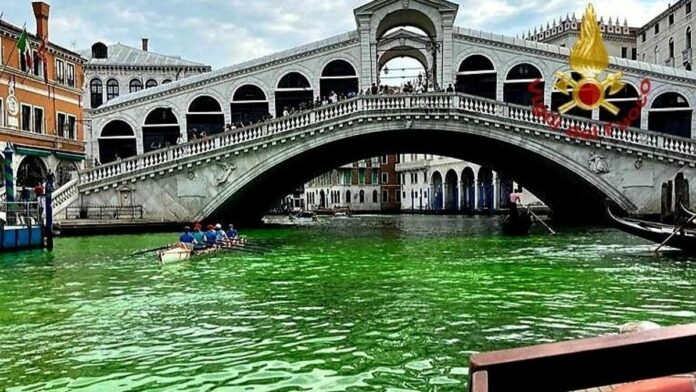Italian authorities have partially solved the mystery of the substance that changed the color of Venice’s canal water.
A patch of water in Venice’s famed Grand Canal turned a shocking—literally and figuratively—green over the weekend, sparking an investigation. Samples collected by firefighters and analyzed by the local environmental protection agency soon revealed there was no danger of pollution, as announced by Veneto’s governor Luca Zaia.
The analysis of the water samples revealed the presence of a non-toxic tinting agent called fluorescein, which is most commonly used in eye tests.
Fluorescein can easily be purchased online, and 250 grams is enough “to produce the effect seen on Sunday,” local newspaper La Nuova Venezia reported. “A person who pours a teaspoon, not seeing the result immediately, can dissolve an excessive dose.”
Who poured fluorescein in the Venice Grand Canal?
Italian authorities have yet to identify the person or people responsible for tinting the waters.
Residents, local outlets, and city authorities all suggest it could be a protest by climate change activists. City councilman Andrea Pegoraro told CNN that environmental activists who have been targeting Italian cultural heritage sites in recent months are the likely culprits.
One such group, Ultima Generazione (Last Generation), denied their involvement in a statement to CNN. The group is known for attention-grabbing protests like pouring diluted charcoal into the Trevi Fountain in Rome, turning it black, and glueing themselves to the frame of a Botticelli painting to call upon Italian leaders to protect and preserve the environment the same way they do art. Last week, two bare-chested activists poured mud over themselves outside the Italian Senate, to highlight the plight of the region of Emilia Romagna that has been hit by deadly floods aggravated by climate change.
The precedent: Fluorescein turned the Venice Grand Canal green in 1968
There is a precedent for turning Venice’s waters fluorescein-green as a form of environmental protest. On June 19, 1968, Argentine eco-artist Nicolás García Uriburu used the dye to tint the waters of Venice’s Grand Canal. “The action, which altered the appearance of the Italian city for the course of one day, aimed to bring attention to the relationship between nature and civilization and to promote ecological consciousness as a critical part of culture,” according to the Metropolitan Museum of Art.
In 1970, Uriburu took this project several steps further, coloring green the East River in New York, the Seine in Paris, the Rio de la Plata in Buenos Aires and, once again, the Grand Canal in Venice.
Throwback: The 2016 Rio Olympic pool turned green—and fluorescein wasn’t to blame
During the 2016 Olympic games, the pool water turned from bright blue to a swampy green “due to a proliferation of algae caused by heat and lack of wind” in the venue. Algae growth was one of the theories being floated for the Venice Canal color change, too, but the water sampled ultimately ruled it out.
Related stories
🏊 The science behind why an Olympic diving pool in Rio suddenly turned a swampy green
🌊 Climate change is altering the color of the oceans
🎯 Big food and fashion companies are setting science-based nature targets for the first time


